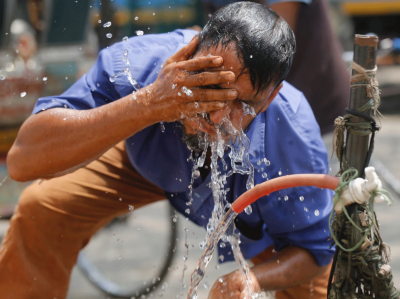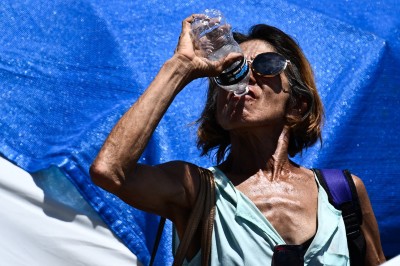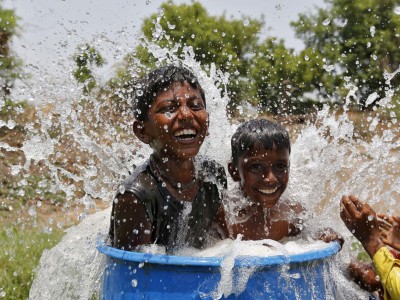This story is part of special report on science and extreme heat. Read about the scientists studying how scorching temperatures affect the body, how climate change is intensifying health problems and the record-breaking warming at the Great Barrier Reef.
George Luber was warming up to compete in his third tennis match on a hot summer’s day in Connecticut. Suddenly, in a daze, he started to drift in circles around the end of the court. Then he began vomiting. The next thing Luber remembers is waking up in hospital, where he was treated for heat stroke for three days. He was a healthy 12-year-old, and it was 1982.
What is the hottest temperature humans can survive? These labs are redefining the limit
Luber, now a medical anthropologist at Emory University in Atlanta, Georgia, knows that those most at risk from extreme heat include older people, pregnant women and outdoor workers. But his experience shows that hot weather can affect you even “if you’re a healthy young person with no pre-existing conditions”.
Extreme heat is a serious public-health threat: on average, it kills more people in the United States than any other weather event, including hurricanes, floods and extreme cold. The effects of scorching temperatures are exacerbated in cities, where buildings and roads soak up warmth. As Earth’s warming climate intensifies the problem, scientists are investigating evidence-based measures to make cities safer during hot periods. Researchers say that although progress has been made to address the threat, there are still obstacles to cities’ efforts to track mortality rates and implement solutions.
Hotspots and habits
Luber has seen first hand the devastating effect that scorching temperatures can have in cities. In 2003, when he was studying extreme heat at the US Centers for Disease Control and Prevention in Atlanta, more than 70,000 people died in one of Europe’s worst heatwaves. Luber flew to Paris, which was particularly hard hit, to study the event. “The morgues were overflowing,” he says. “They had to get refrigerated trucks to put the bodies in and it was a massive panic.”
Extreme heat harms health — what is the human body’s limit?
Cities are hotspots because of the urban ‘heat island’ effect: buildings, roads and other impervious surfaces absorb the Sun’s heat during the day and radiate warmth into the night, raising air temperatures. High night-time temperatures amplify the problem, Luber says, because the body can only withstand searing heat for short periods. Illnesses related to heat can develop slowly, when people cannot find respite for several days. That’s why the highest mortality rates occur a few days into a heatwave, he says.
The stagnant air that accompanies a heatwave also magnifies air pollution, because ground-level ozone and particulate matter become more concentrated when the air does not circulate. Cities with high levels of air pollution, such as Los Angeles in California and Beijing face dismal air quality when the heat rises. This can compound the effects of heat on health.
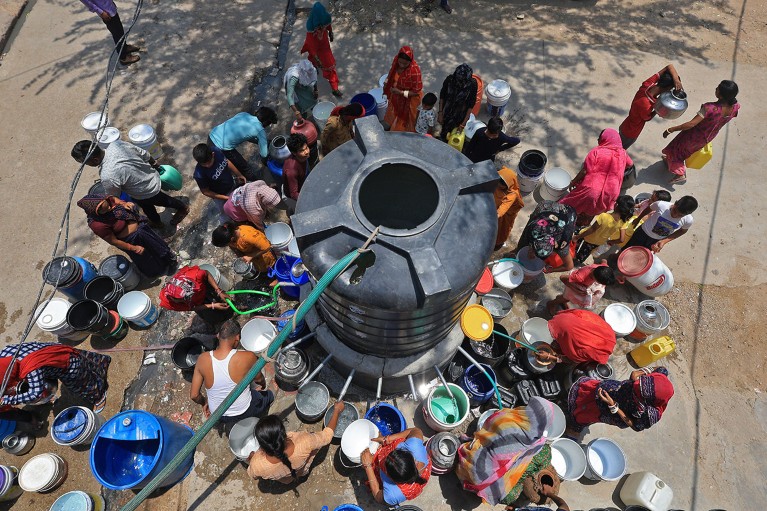
Cooling stations with water can help people to lower their core body temperatures when conditions are scorching.Credit: Vishal Bhatnagar/NurPhoto via Getty
As the climate changes, places already burdened with extreme heat are now projected to have more dangerous heat days per year. But heatwaves will be deadliest in places that have historically not suffered from extreme high temperatures, Luber says, “because dealing with the heat is not only a physical thing, it’s a cultural and behavioural thing”.
Local solutions
Small shifts in behaviour alone will not protect people from heat. Eleni Myrivili is global chief heat officer at the United Nations Human Settlements Programme and is based in Athens, where summer temperatures can exceed 40°C. A 16-day heatwave in the city this July was “absolutely unbearable”, Myrivili says. “It’s almost like the whole city is in a state of depression. Nobody wants to do anything, everybody’s feeling kind of nauseated and kind of weird.”
Cities should approach the problem by raising awareness, providing resources and redesigning the built environment, Myrivili says.
Vulnerable populations, including people living in poverty, need to know that they are at risk and where they can access services when temperatures rise. Myrivili suggests that cities set up cooling stations — with air conditioners, fans and water — in areas that have the least relief from the heat, so that people can lower their core body temperatures for a recommended 2–3 hours per day. She also says that insurance should be available to people who work outdoors to cover lost wages when weather conditions make working unsafe.
Such a scheme was trialled in India in May, which has been experiencing periods of deadly heat. A non-profit organization called Climate Resilience for All partnered with the insurance company Swiss Re to help cover the lost wages of 46,000 women when temperatures became dangerous.
Dileep Mavalankar, former director of the Indian Institute of Public Health in Gandhinagar, helped to create India’s first ‘heat action plan’ in the city of Ahmedabad in 2013 after a 2010 heatwave killed 1,344 people there. The plan includes making public announcements in the days before high temperatures, providing cooling stations and preparing the emergency services for the event.
Cities must protect people from extreme heat
Mavalankar says that although these measures are probably helping, he cannot assess by how much, because death-registration data are not systematically made public.
Even in places where national data are available, gaps in local information can make understanding and addressing the problem difficult. Greece, for instance, does not collect hospital data linking mortality and morbidity to extreme heat. Instead, after a heatwave, the national death toll is estimated by comparing how many people normally die with how many people died during the hot period. Myrivili doesn’t know how many died during the latest heatwave in Athens, or which areas were hit the hardest.
Green cities
Redesigning cities to have more green, natural features that provide shade and release moisture is the next step. Growing trees and increasing access to cool outdoor spaces “can make a difference between life and death”, Myrivili says. But “even though we know, generally, what the solutions are, they need to be custom made and adapted to the specifics of very localized challenges”.
A study published on 12 August in Nature Medicine1 shows that some strategies might be working. Elisa Gallo, an epidemiologist at the Barcelona Institute for Global Health in Spain, and her colleagues estimated that 47,690 people in Europe died from heat in 2023. Using statistical modelling, the team calculated that if the record-breaking heat of 2023 had occurred at the start of the century, the death toll would have been 80% higher than if it had happened between 2015 and 2019.
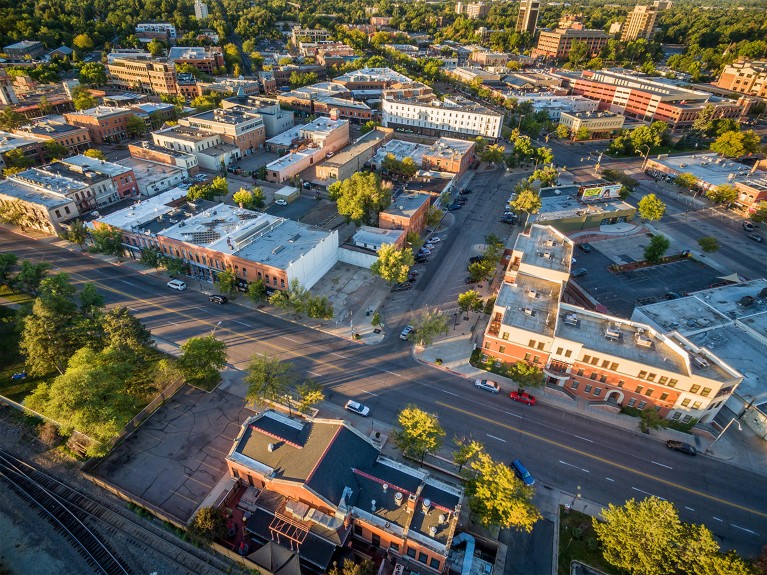
The city of Fort Collins in Colorado is working with scientists to introduce effective cooling features such as trees.Credit: Marek Uliasz/Alamy
Although it’s not clear which policies work best, Gallo says that European countries are now better able to protect people than they were in 2003. Her next step is to assess the strategies key to achieving this. “Climate change needs to be considered as a health issue,” Gallo says, adding that extreme-weather events might be the easiest way for people to understand that.
Better data
Improved data collection is one thing that would help scientists to assess strategies’ effectiveness. For instance, many studies analysing the urban heat-island effect use satellite data, which tend to measure surface temperatures. Melissa McHale, an urban ecologist at the University of British Columbia in Vancouver, Canada, says that can lead to misguided policies.
She offers the example of painting roads and buildings white. “We realized when we were standing in those white places that it was really uncomfortable, but from the satellite it looked cooler,” she says. Instead of absorbing the Sun’s heat, white roads reflect it onto people — who experience radiant and ambient air temperatures rather than the surface temperature, she says. Although studies show that making roofs white can reduce temperatures in cities by a couple of degrees, painting roads white — as has been done in Phoenix, Arizona, and Los Angeles — could worsen the problem for pedestrians.
McHale is working with the city of Fort Collins in Colorado on which solutions to implement and where — such as the addition of trees to bus stops. Her team is measuring air temperatures around homes and analysing water and energy consumption — a hyper-local approach that she says will help the city to budget resources to improve people’s comfort.
She also suggests that cities dedicate more space to parks, but notes that this is difficult when balancing needs such as affordable housing and keeping water use low in arid places.
The idea of ‘depaving’ — tearing out roads and car parks and replacing them with green space — is growing in popularity in cities such as Portland, Oregon, and Amsterdam. “We’re addicted to the car, and it’s going to be hard to build liveable cities when we’re building cities for cars,” McHale says.
There is promise in the fact that cities are constantly being rebuilt, Luber says — the average construction turnover is 30–50 years. “Every single heat death can be prevented, we just need to have the resources and willingness to do it.”



